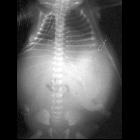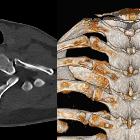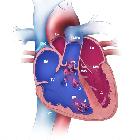pentalogy of Cantrell

Newborn with
a midline defect including a split anterior half of the sternum, a thoracoabdominal ectopic cordis, and an omphaloceleCXR and AXR shows the cardiac margin to be absent below the level of the diaphragm. The left lung is hyperlucent compared to the right. There is a paucity of bowel gas within the abdomen and centralization of bowel loopsThe diagnosis was Pentalogy of Cantrell and ascites.

Class II
pentalogy of Cantrell. CT scan of the patient done during first month of life, showing loops of bowel protruding in the anterior abdominal wall defect (demonstrated by the arrow).

Class II
pentalogy of Cantrell. Axial CT scan of the patient showing the heart bulging though the anterior abdominal wall defect proximal to air filled bowel loops.

Duplication
of the ALDH1A2 gene in association with pentalogy of Cantrell: a case report. Computed tomography scan. A sagittal view from a contrast-enhanced computed tomography study demonstrating protrusion of the right ventricle through the sternal defect (a) and extra-abdominal position of the organs in the large omphalocele (b).
The pentalogy of Cantrell is an extremely rare phenomenon with an incidence estimated at around 6 per million live births .
It encompasses the following 5 main features
Pathology
It is thought to result from an abnormal migration of the sternal anlage and myotomes in the early embryonic stage ( ~ 6 to 7 week of gestation).
Associations
- cystic hygroma
- craniofacial anomalies
- trisomies
- vertebral anomalies
- limb anomalies
Treatment and prognosis
Most cases carry a very poor prognosis. The diversity and complexity of pentalogy of Cantrell results in a variable clinical course requiring unique surgical approaches . Surgical management aims to :
- correct cardiac malformations
- ensure adequate space for return of the heart to the mediastinum
- protect the heart from compression and distortion via repair thoracoabdominal wall defects
History and etymology
It was first described by James R Cantrell in 1958.
See also
Siehe auch:
- Hydrocephalus
- Pätau-Syndrom
- angeborene Wirbelanomalien
- Atriumseptumdefekt
- Trisomie 18
- Fallot'sche Tetralogie
- Lippen-Kiefer-Gaumen-Spalte
- Meningoenzephalozele
- zystisches Lymphangiom
- Omphalozele
- trisomies
- Ventrikelseptumdefekt
- pentalogy of Fallot
- Fissura sterni congenita
- Herzektopie
- Zwerchfelldefekte
- cardiovascular malformations
und weiter:

 Assoziationen und Differentialdiagnosen zu Cantrell’sche Pentalogie:
Assoziationen und Differentialdiagnosen zu Cantrell’sche Pentalogie:














